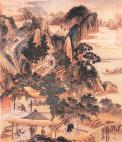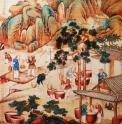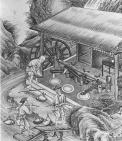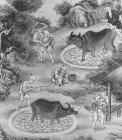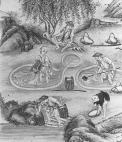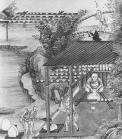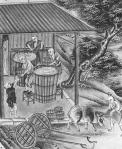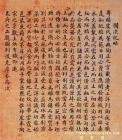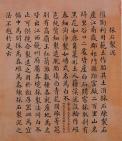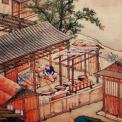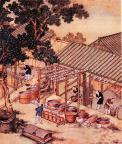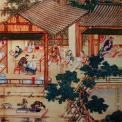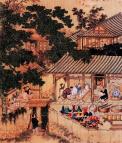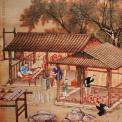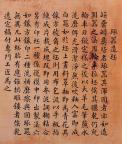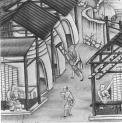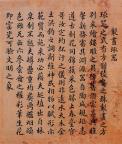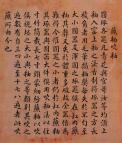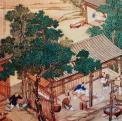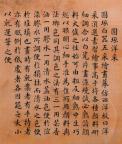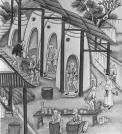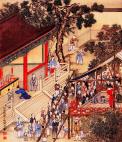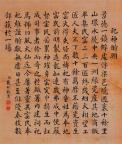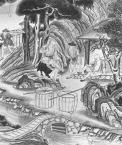Tang Ying, the supervisor of porcelain production at the official kilns in Jingdezhen in the 18th century.
In the 8th Year of Qianlong Reign (1743) 8th day of the 4th month in the Lunar Calendar Palace Eunuchs Hu shi Jie and Gao Yu delivered 20 copies of illustrations on Pottery Making to the Qing dynasty emperor Qianlong (1735-1796). He then ordered: “Send these Pictures to Tang Ying (1) to compose text describing in detail on every picture the process of manufacturing. The sentences should be refined and the numbers of wordings should be evenly distributed about 10 characters more or less in number. The mountains and the rivers where the raw materials were extracted, clay and water, the artisans involved, all must be named in detail. Then he should return all the 20 copies of the illustrations together with text in series of their order of procedures in the making. That’s it, I am here to command you.” (2) The original text was translated by S. W. Bushell in 1899 and is quoted below together with some of the original illustations. The sketches on the right are made sometime later.
1. Mining the clay and Pulverizing to muddy consistency 采石制泥
The village of Gaoling (Kao-ling) seen from the "high ridge" where the kaolin clay was quarried up until the late Ming dynasty. In the manufacture of porcelain the body is formed of molded earth. This earth is prepared from stone, which must be mined and purified for the purpose. The stone (China stone) is found in the province of Kiangnan, within the prefecture Hui-chou Fu, at Ch'i-men-hsien, which is two hundred li distant from the porcelain manufactory.
The two mountains called P'ing-li and K'u-k'ou, in this district, both produce the white stone. It is obtained by mining, and when broken exhibits black veins branching like the deer's-horn seaweed. The natives take advantage of the mountain torrents to erect wheels provided with crushers. Having been finely pulverized, it is then purified by washing and levigation, and made up in the form of bricks, which are called pai-tun or "white bricks" (petuntse). When the color is uniform and the texture perfectly fine, it is used for the making of the round pieces and vases of eggshell and of pure white porcelain, and of similar objects decorated in blue.
Besides this there are several other kinds of earth called Kao-ling, Yu-hung, and Ch'ien-t'an, after their different places of production, which are all situated in the province of Kiangsi, within the bounds of the prefecture Jao-chou Fu. They are dug out and prepared in the same way as the petuntse, and can only be used for mixing with this last, or in the making of coarser and thicker ware.
2. Processing and purifying the muddy clay 淘炼泥土.
In porcelain-making the first requisite is that of washing and purifying the materials of the paste, so as to make it of fine homogeneous texture. The presence of "stars" or of fragments of stone would cause flaws in the porcelain. Foreign particles or loose paste would lead to cracks. The method of purifying the paste is to mix the materials with water in large earthenware jars, and to stir the mixture with wooden prongs, so that it remains suspended in the water while the impurities sink to the bottom. The paste is then passed through a fine horsehair sieve, and next strained through a bag made of a double layer of silk. It is then poured into a series of earthenware jars, from which the water is run off, and the paste is left to become solidified. A wooden box with no bottom having been placed upon a pile composed of several tiers of new bricks, a large cloth of fine cotton is spread inside, and the solidified paste is poured in, wrapped round with the cloth and pressed with more bricks, which absorb all the water.
The prepared paste, freed from the superfluous water, is then thrown on to large stone slabs and worked with iron spades until it has become perfectly compact and ductile, and fit for the manufacture of porcelain. All the different kinds of paste are prepared in the same way, the various materials having been mixed in definite proportions according to their different properties. The picture contains in detail the various utensils and the different processes of work comprised in this department of preparation of the paste.
3. Processing of ashes to formulate glazes 炼灰配釉
All kinds of porcelain require glaze, and the composition used for glazing can not be prepared without ashes. The ashes for the glaze come from Lo-p'ing-hsien, which is one hundred and forty li to the south of Jingdezhen. They are made by burning a gray-colored limestone with ferns piled in alternate layers. The residue - after it has been washed thoroughly with water - forms the ashes for the glaze.
The finest kind of petuntse made into a paste with water is added to the liquid glaze ashes, and mixed to form a kind of purée, the proportions being varied according to the class of porcelain. Within the large jar, in which the mixture is made is placed a little iron pot, through the two handles of which a curved stick is passed, to make a ladle for measuring the ingredients. This is called a p'en. For example, ten measures of petuntse paste and one measure of ashes form the glaze for the highest class of porcelain. Seven or eight ladles of paste and two or three ladies of ashes form the glaze for the middle class. If the paste and ashes are mixed in equal proportions, or if the ashes are more than the paste, the glaze is only fit for coarse ware.
4. Making of fire-resistant clay boxes 制造匣钵
The porcelain while being fired in the furnace must be kept perfectly clean. A single spot of dirt makes a colored stain. Moreover, the blast of air and fierce flames of the furnace would injure the delicate paste. For these reasons it is necessary to place the porcelain inside the saggars. The clay used in making these cases comes from the village of Li-ch'un, which is on the northeast of Jingdezhen. It is of three different colors - black, red, and white. A kind of blackish-yellow sand, which is found at Pao-shih-shan, is mixed with the clay to form the paste, so that it may be more readily fired.
The cases are fashioned on a wheel, which is similar to the wheel used for porcelain. The paste need not be finely levigated. After the cases have been partially dried they are roughly finished off with the knife, put into the furnace, and fired for the first time empty. When baked and ready for use, they are called by the name of tu-hsia, or "finished cases". The workmen who manufacture the saggars are accustomed with the same coarse paste to make, on the same wheel, a supply of earthenware bowls for the daily use of the potters in their native hamlets.
5. Molding 圆器修模
In the manufacture of the round ware each several piece has to be repeated hundreds or thousands of times. Without molds it would be most difficult to make the pieces all exactly alike. The molds must be made in accordance with the original design, but the size can not be so precisely measured; they must be larger than the model, otherwise the piece will come out smaller than the pattern. The raw paste, which is expanded and loose in texture, becomes during the process of firing contracted and solidified to about seven or eight tenths of its original size, a result following from the natural laws of physics.
The proper proportionate size of the unbaked piece is fixed by the mold, and therefore the molders use the term 'prepare' instead of 'make'. Each piece must have several molds prepared, and the size and pattern of the contents when taken out of the kiln must be exactly alike. A good practical knowledge of the length of firing required and of the natural properties of the paste is necessary before it is possible to estimate the exact amount of shrinkage, so as to fashion the molds of the proper form. In the whole district of Jingdezhen there are only three or four workmen reputed clever at this special handiwork.
6. Throwing 圆器拉坯
There are several different processes of work in the manufacture of this round ware. The square, polygonal, and ribbed pieces, and those with projecting corners, have to be carved, engraved, molded, and finished with the polishing knife, all of which are different branches of work. The plain round pieces are turned on the wheel, being distributed according to their size between two classes of workmen. The first take the large pieces and fashion the round dishes (p'an), the bowls (wan), the cups (chung), and the saucer-plates (tieh), from one up to two or three feet in diameter; the second make on the wheel the same kind of pieces which measure less than a foot across.
The wheel consists of a disk of wood mounted below upon a perpendicular axle, so as to revolve continuously for a long time, during which the piece must be properly turned, without becoming too thick, too thin, flattened, or otherwise misshapen. There is a carpenter at hand to repair it when necessary. Beside the wheel is an attendant workman, who kneads the paste to a proper consistency and puts it on the table. The potter sits upon the border of the framework and turns the wheel with a bamboo staff.
While the wheel is spinning round he works the paste with both hands; it follows the hands, lengthening or shortening, contracting or widening, in a succession of shapes. It is in this way that the round ware is fashioned so that it varies not a hair's breadth in size.
7. Carving into Forms and Body works 琢器做坯
The vases and sacrificial vessels, called p'ing, lei, tsun, and yi, are comprised in this general name of cho ch'i. The plain round vases are fashioned upon the potter's wheel, in the same manner as the ordinary round ware; they are then dried in the open air and turned on the polishing wheel to be finished with the knife. After the vase has been thus shaped it is washed with a large goat's-hair brush dipped in water, till the surface is perfectly bright and spotlessly clean. After this the glaze is blown on, it is fired in the kiln, and comes out a piece of white porcelain. If painted in cobalt on the paste and then covered with glaze, it is apiece decorated in blue.
In making the carved polygonal, ribbed, and fluted vases, the paste, wrapped in cotton cloth, is pressed with flat boards into thin slabs, which are cut with a knife into sections. The pieces are joined together by some of the original paste diluted with water. There is another kind of vase which is made by the process of molding, and which is finished after it is taken from the mold in the same way.
The carved polygonal vases and the carved molded vases have to be filled in and washed clean with the brush in the same way as the round vases turned upon the wheel. All the varied forms of vases may be engraved with the style, or embossed in relief, or carved in openwork designs, for which purposes, when sufficiently dried, they are given to artificers specially devoted to these several branches of work.
8. Extracting Blue hue 采取青料
All kinds of porcelain, whether round ware or vases, that have to be decorated in blue, whether modeled after that of the reigns of Hsuan-te, Ch'eng-hua, Chia-ching, or Wan-li, require this blue color for the painting of their decoration. The deep blue monochrome glaze also requires this blue for its preparation. The material comes from the province of Chekiang, where it is found in several mountains within the prefectures Shao-hsing Fu and Chin-hua Fu.
The collectors who go into the hills to dig for it wash away the earth that adheres to it in the water of the mountain streams. The mineral is dark brown in color. The large round pieces furnish the best blue and a called 'best rounds,' distinguished in addition by the name of the place of production. It is brought by merchants to the porcelain manufactory, and is buried by them under the floor of the furnace roasted for three days, and washed after it is taken out, before it is finally offered for sale, ready for use.
The material is also found in different mountains in the provinces of Kiangsi and Kuangtun but the color produced by these kinds is comparatively pale and thin, and it is unable to supply the fire, so that they can be used only inpainting coarse ware for sale in the market.
9. Processing and purifying the formulated blue hue 炼选青料
The blue material, after it has been roasted, must be specially selected, and there is a particular class of workmen whose duty it is to attend to this. The superior kind selected is that which is dark green in color, of rich translucent tint and brilliant aspect. This is used in the imitation of antiques, for the monochrome blue glaze, and for fine porcelain painted in blue. When of the same dark-green color, but wanting somewhat in richness and luster, it is used for the decoration of the coarser porcelain made for sale. The remainder, that has neither luster nor color, is picked out and thrown away.
When the material has been selected it is ready for use. The method employed is to paint with it upon the piece that has not been fired, to invest the piece afterward with glaze, and then to fire it in the furnace, from which it comes out with the color uniformity transformed into a brilliant blue. If it has not been invested with glaze the color will be black. Should the piece be overfired, the blue of the painted decoration will 'run' into the white ground of the piece.
There is one kind of blue, commonly called onion sprouts, which makes very clearly defined strokes that do not change in the furnace and this must be selected for fine painting.
10. Embossing materials on body work 印坯乳料
After the large and small round pieces have been shaped on the wheel and have been sufficiently dried in the air they are put into the molds which have been previously prepared and are pressed gently with the hands until the paste becomes of regular form and uniform thickness. The piece is then taken out and dried in a shady place till it is ready to be shaped with the polishing knives. The damp paste must not be exposed to the sun, as the heat would crack it.
With regard to the preparation of the color for the artists, it must be ground perfectly fine in a mortar; if coarse, spots of bad color will appear. Ten ounces of the material are put into each mortar, and a special class of workmen grinds it for a whole month before it is fit to be used. The mortars used for grinding it are placed upon low benches, and at the sides of the benches are two upright wooden poles supporting cross-pieces of wood, which are pierced to hold the handles of the pestles.
The men, seated upon the benches, take hold of the pestles and keep them revolving. Their monthly wage is only three-tenths of an ounce of silver. Some of them grind two mortars, working with both hands. Those who work till midnight are paid double wages. Aged men and young children, as well as the lame and sick, get a living by this work.
11. Blue and white paint work 圆器青花
The different kinds of round ware painted in blue are each numbered by the hundred and thousand. If the painted decoration upon every piece is not exactly alike, the set will be irregular and spotted. For this reason the men who sketch the outlines learn sketching, but not painting; those who paint study only painting, not sketching; by this means their hands acquire skill in their own particular branch of work, and their minds are not distracted. In order to secure certain uniformity in their work, the sketchers and painters, although kept distinct, occupy the same house.
As to the other branches of work - embossing, engraving, and carving in openwork - they are treated in the same way, and each is entrusted to its own special workmen. The branch of decorating in underglaze red, although really distinct, is allied to that of painting.
With regard to the rings round the borders of the pieces and the encircling blue bands, these are executed by the workmen who finish the pieces on the polishing wheel while the marks on the foot underneath and the written inscriptions, are the work of the writers who attach the seals. For painting flowers and birds, fishes and water-plants, and living objects generally, the study of Nature is the first requisite; in the imitation of Ming dynasty porcelain and of ancient pieces, the sight of many specimens brings skill. The art of painting in blue differs widely from that of decoration in enamel colors.
12. Painting on the body 制画琢器
The different forms of vases and sacrificial vessels comprised in the general term of cho ch'i include the square, the round, the ribbed, and those with prominent angles. There are various styles of decoration executed by painting in colors and carving in openwork. In copies from antiquity artistic models must be followed; in novelty of invention there is a deep spring to draw from. In the decoration of porcelain correct canons of art should be followed; the design should be taken from the patterns of old brocades and embroidery, the colors from a garden as seen in springtime from a pavilion.
There is an abundance of specimens of the Kuan, Ko, Ju, Ting and Chun at hand to be copied; and water, fire, wood, metal, and earth (the five elements of physics) supply an inexhaustible fund of materials for new combinations of supernatural beauty. Natural objects are modeled, to be fashioned in molds, and painted in appropriate colors; the materials of the potter's art are derived from forests and streams and ornamental themes are supplied by the same natural sources. The sacrificial wine-vessels, tsun and lei, are of equal importance; the censers, shaped like the ancient bronzes, yi and ting, emit flames of brilliant color. In addition to the ancient earthenware drums (wa fou), many kinds of musical pipes are now made, and the artistic skill of the color-brush perpetuates on porcelain clever works of genius.
13. Glazing by blowing or touching 蘸釉吹釉
All the different kinds of round ware and vases, including the pieces decorated in blue, as well as the copies of Kuan, Ko, and Ju porcelain, must have the glaze applied before they are fired. The ancient method of putting on the glaze was to apply it to the surface of the vase, whether square, tall, fluted, or ribbed, with a goat's-hair brush filled with the liquid glaze, but it was difficult to distribute it evenly in this way. The round ware, both large and small, and the plain round vases and sacrificial vessels used all to be dipped into the large jar which held the glaze, but they failed by being either too thickly or too thinly covered, and, besides, so many were broken that it was difficult to produce perfect specimens.
In the present day the small round pieces are still dipped into the large jar of glaze liquid, but the vases and sacrificial vessels and the larger round pieces are glazed by the soufflé process. A bamboo tube one inch in diameter and some seven inches long has one of its ends bound round with a fine gauze, which is dipped repeatedly into the glaze and blown through from the other end. The number of times that this process has to be repeated depends partly on the size of the piece, partly on the nature of the glaze, varying from three or four times up to seventeen or eighteen. These are the two distinct methods of glazing: by immersion and insufflation.
14. Using knife to retouch the body & foot base 镟坯挖足
The size of the round piece has been fixed in the mold, but the smooth polish of the surface depends on the polisher, whose province is another branch of work, that of 'turning.' He uses in his work the polishing wheel, which in form is like the ordinary potter's wheel, only it has projecting upward in the middle a wooden mandrel, the size of which varies, being proportioned to that of the porcelain which is about to be turned. The top of this mandrel, which is rounded, is wrapped in raw silk to protect the interior of the piece from injury. The piece about to be turned is put upon the mandrel, the wheel is spun round, and it is pared with the knife till both the inside and outside is given the same perfectly smooth polish. The coarser or finer finish of the form depends upon the inferior or superior handiwork of the polisher, whose work is consequently of great importance.
With regard to the next process, that of scooping out the foot, it is necessary, because each piece, when first fashioned upon the potter's wheel, has a paste handle left under the foot two or three inches long, by which it is held while it is being painted and glazed.
It is only after the glazing and the painting of the decoration are finished that this handle is removed by the polisher, who at the same time scoops out the foot, after which the mark is written underneath.
15. Preparation for firing 成坯入窑
The kiln is long and round, and resembles in shape a tall water-jar (weng) turned over on its side. It measures a little over ten feet in height and breadth, about twice as much in depth. It is covered with a large, tiled building which is called the 'kiln-shed.' The chimney, which is tubular, rises to a height of over twenty feet behind, outside the kiln-shed.
The porcelain, when finished, is packed in the saggars and sent out to the furnace men. When these men put it in the kiln they arrange the saggars in piles, one above the other, in separate rows, so as to leave a space between the rows for the free passage of the flames. The fire is distinguished as front, middle, and back; the front of the fire is fierce, the middle moderate, the back feeble. The different kinds of porcelain are placed in the furnace according to the hard or soft quality of the glaze with which they are coated. After the kiln has been fully charged the fire is lighted, and the entrance is then bricked up, leaving only a square hole, through which billets of pinewood are thrown in without intermission.
When the saggars inside the furnace have attained a silvery red color (white heat) the firing is stopped, and after the lapse of another twenty-four hours the kiln is opened.
16. Firing processes 烧坯开窑
The perfection of the porcelain depends upon the firing, which, reckoning from the time of putting in to that of taking out, usually occupies three days. On the fourth day, early in the morning, the furnace is opened, but the saggars inside, which contain the porcelain, are still of a dull-red color, and it is impossible to enter yet. After a time the workmen who open the kiln, with their hands protected by gloves of ten or more folds of cotton soaked in cold water, and with damp cloths wrapped around their heads, shoulders, and backs, are able to go in to take out the porcelain.
After the porcelain has all been removed and while the furnace is still hot the new charge of ware is arranged in its place. In this way the new porcelain, which is still damp, is more gradually dried, and is rendered less liable to be broken into pieces or cracked by the fire.
17. Coloring paint work 圆琢洋采
Both round ware and vases of white porcelain are painted in enamel colors in a style imitate from Western foreigners, which is consequently called Yang ts'ai, or 'Foreign Coloring.' Clever artists of proven skill are selected to paint the decoration. The different materials of the color having been previously finely ground and properly combined, the artist first paints with them upon a slab of white porcelain, which is fired to test the properties of the colors and the length of firing they require. He is gradually promoted from coarse work to fine, and acquires skill by constant practice; a good eye, attentive mind, and exact hand being required to attain excellence.
The colors which are employed are the same as those used for cloisonné enameling upon copper (Fa-lang). They are mixed with three different kinds of medium, the first being turpentine the second liquid glue, the third pure water. Turpentine is best adapted for free coloring; glue is more suitable for thin washes, water for retouching the colors in relief. While it is being painted the piece is either supported upon a table or held in the hand, or laid upon the ground, according to its size and it is laced in the position most convenient for the read use of the brush.
18. Types of furnaces 明炉暗炉
White paste porcelain that has been previously fired in the furnace is first decorated by the artist with painting in colors. When it has been painted in colors it must be again fired to fix the colors. For this purpose two kinds of muff le stoves are used, one kind being open, the other closed. The open stove is used for the smaller pieces. This stove is similar to that used for cloisonné enamels on copper, and it has a door opening outward.
When the charcoal fire has been lighted inside, the porcelain is placed upon an iron wheel, which is supported upon an iron fork, by which the porcelain is passed into the stove, and the fireman holds in his other hand an iron hook, so that he may be able to turn the wheel around in the fire to equalize the action of the heat. When the colors appear clear and bright the firing is reckoned to have been sufficient.
For large pieces the closed stove is employed. This stove is three feet high and nearly two feet and three-quarters in diameter. A double wall to hold the charcoal fire, the wall being perforated below for the entrance of air, surrounds it. The porcelain is introduced into the interior of the stove, while the man holds a circular shield to protect him from the heat of the fire. The top of the stove is then closed by a flat cover of yellow clay and closely luted. The firing takes a period of about twenty-four hours.
19. Packing into container & cushioning with hay bundle 束草装桶
After the porcelain has been taken out of the furnace it is arranged into four separate classes, which are known by the names of first-class color, second-class color, third-class color, and inferior ware, and the price is fixed accordingly at a high or low rate. The porcelain of third-class color and the inferior ware are kept back for local sale. The round ware of first-class color and the vases and sacrificial vessels of the first and second class are all wrapped up in paper and packed in round cases, there being packers whose duty it is to attend only to this work.
With regard to the round ware of second-class color, the dishes and bowls are tied together in bundles, each composed of ten pieces, which are wrapped round with straw and packed in round cases, for convenience of carriage to distant parts. The coarser porcelain intended for ordinary use, which is distributed throughout the different provinces, is not packed in cases with straw, but only tied up in bundles with reeds and matting. From thirty or forty pieces up to sixty make a 'load' sufficient for a man to carry at each end of his yoke.
The 'loads' are packed inside with reeds and matting and bound round outside with strips of bamboo, ready to be conveyed either by water or by land as may be more convenient.
The workmen who do the packing are generally known by the name of mat-men.
20. Thanksgiving Rituals 祀神酬原
Jingdezhen, situated within the jurisdiction of Fou-liang Hsien, is only some ten or more li in circuit, environed by mountains and rivers, so as to form, as it were, an island, yet on account of its porcelain production merchants throng to it from all quarters.
The private kilns, between two and three hundred in number, exhibit a constant succession of flames and smoke the whole year round, and give employment to not less than several hundreds of thousands of workmen and assistants. The porcelain industry gives subsistence to an immense number of people whose life hangs on the success or failure of the furnace fires, and they are all devout in worship and sacrifice.
Their god, named T'ung, was once himself a potter, a native of the place. Formerly, during the Ming dynasty, when they were making the large dragon fish bowls, they failed in the firing year after year, although the eunuchs in charge inflicted the most severe punishments, and the potters were in bitter trouble. Then it was that one of them, throwing away his life for the rest, leaped into the midst of the furnace, whereupon the dragon bowls came out perfect.
His fellow-workmen, pitying him and marveling, built a temple within the precincts of the imperial manufactory, and worshiped him there under the title of Genius of Fire and Blast. Down to the present day the fame of the miracle is cherished, and the potters continue to worship him, not a day passing without reverential sacrificial offerings. Theatrical shows are also instituted in his honor, during which crowds of people fill the temple grounds. He is worshiped here as the tutelary gods of agriculture and land are in other parts of the empire.
The Wanli Shipwreck.com
Tang Ying, the supervisor of imperial porcelain production at Jingdezhen. This site also offers antique Chinese porcelain and other Asian antiques
Click on above images to view Antique Ming dynasty Porcelain for sale
Nanhai Marine Archaeology Sdn. Bhd.
1. About Tang Ying:
雍正,乾隆时期的督陶官 - 唐英可以说多才多艺,他不仅是清代著名的剧作家,还
在绘画,篆刻,诗词,都有很高的造诣。在陶瓷发展史上,他为雍正,乾隆时期的陶瓷
繁盛发展,做出了不可磨灭的贡献。可以说做出了开天辟地的事业。
Tang Ying was a Supervisor in the Imperial Pottery Work during the Yong Zhen and the Qianlong Periods. He was multi-talented, exhibiting his skills, not only in script-writing, but also in painting, engraving seal script, and poetry, in that he had never failed to achieve to an excellent standard. In the history of the development of pottery making, he had made an indelible contribution to the prosperity of ceramic arts during that period. We can say that he has widened the field for future development.
In the “Qing Chronicle” he was described as thus:
唐英,字俊公,汉军旗人。官内务府员外郎,直养心殿。雍正六年,命监江西
景德镇窑务,历监粤海关、淮安关
Tang Ying alias Jun Gong was a native from Han Jun Qi. He served as Deputy Officer of the Internal Affairs in the Hall of Mental Cultivation of the Royal Palace. In the 6th year of the Yong Zhen Reign, he was decreed to supervise the Royal Pottery Work in Jingdezhen of the Jiangxi Province; also co-in-charge of matters arising from Canton Custom Building and that of the Custom And Excise in Huai-an river port.
乾隆初,调九江关,复监督窑务,先后在事十 馀年。明以中官督造,
后改巡道,督府佐司其事,清初因之。
In the early year of the Qianlong, he was transferred to another river port of Jiu Jiang in Jiangxi, also supervising pottery work for duration of ten over years. At first, as a supervisor in the pottery making, later his duties extended to be a Deputy director of a prefectural office.
顺治中,巡抚郎廷佐所督造,精美有名,世称“郎窑”。其后御窑兴工,
每命工部或内务府司官往,专任其事。年希尧曾奉使造器甚夥,世称“年窑”。
During the reign of Shun zhi (1644–1662), a Jiangxi Provincial government officer, by the name of 郎廷佐Lang Ting Zuo had, under his area of administration, the royal Kilns produced beautiful imperial wares, later known as Lang wares, in honor of his name. Subsequently, the imperial kilns became active, the Ministry of Work (工部) and the Department of Palace Internal Affair (内务府) frequently and specifically delegated officers to supervise their Kiln works. 年希尧 Nian Xi Yao was one of the Imperial officers who was assigned for the job, under whose tenure, many beautiful state-of-the-art wares were produced, people called them Nian wares, also in honor of his name.
英继英继其后,任事最久,讲求陶法,於泥土、釉料、坯胎、火候,具有心得,躬
自指挥。又能恤工慎帑,撰 陶成纪事碑,备载经费、工匠解额,胪列诸色赩釉,仿古
采今,凡五十七种。自宋大观,明永乐、宣德、成化、嘉靖、万历诸官窑,及哥窑、定
窑、均窑、龙泉窑、宜兴窑、西洋、东洋诸器,皆有仿制
Tang Ying took over the position after Nian, he served the longest term in tenure, strictly and personally supervising the procedures in pottery making, right from the choice of clay, glazed materials, forms and body work, to the firing temperature, all attending to details. He had made detail records of the work ranging from various dark red glaze monochrome ceramics to the reproduction of ancient arts totaling 57 varieties. The records also covered Cost and labors, craftsmanship etc.. The reproduction works imitating ancient forms and designs encompassed that of the Song Period like that of the Ge-wares, Ding-wares, Jun-wares, Long-quan, Yi-xing etc.. the Ming imperial wares of the Yongle, Xuande, Chenghua, Jiajing, Wanli etc.. also work of arts from East (Japanese or Korean wares) and West (of China) were copied for reproduction.
2. Tang Yings reply:
奴才接到来文,随钦遵谕旨,敬谨办理。按每幅图同所做技业,并取土取料之
山,逐一编明,并将图幅先后次第,另编总幅,恭呈御览。至陶务为琐屑工作,图既未
备,编亦不能详列。惟谨就图中所载,遵旨编次,伏祈皇上睿鉴。
再,奴才近日造得奉发之样件并新拟样瓷,一并呈览,敬请皇上教导改正,以便钦遵
烧造,谨奏。 朱批:览。
After receiving the royal command, I Immediately took action. According to every copy of the pictures, I describe the technique used, and also describe in detail the mountain where the raw materials are extracted, the pictures are attached with texts arranged in order of their procedures of making, condense to a pictorial; I hereby submit it for your royal comment. Pottery work is such a complex of petty details. As the pictures are not adequate, texts could not be composed in detail. I can only compose text based on the picture provided, and then arrange them in order, I beg for your royal pardon.
Again, I hereby attached a sample which I recently design, intending for ceramic work. This is
for your royal comment and approval, before sending it for firing.
以上这些档案中清楚的记载了乾隆在制作《陶冶图》时对唐英的要求,以及唐英
本人的诚恳态度。有幸,此套《陶冶图》得以流传,1996年,香港一拍卖会拍出
此套《陶冶图》册.
From the records of the above files and memos, we can understand that, in the process of compiling “The Illustrated Techniques on Pottery Making” , the conditions the emperor Qianlong demanded and the earnest attitude of Tang Ying in accepting the responsibility.
We are lucky that this original copy of “The Illustrated Techniques on the Pottery Making” is still in preservation. In 1996, this manual (of illustations and text) was sold at an auction in Hong Kong where it is still kept by a well-known collector
Mountain area outside Jingdezhen where the clay was mined
Washing the raw clay before packing it into clay 'bricks'
Pulverizing the China stone by water driven pestles
Water buffalos was used to mix the raw clay
1. Mining the clay and pulverizing to muddy consistence
Final skimming of the clay and transporting it to the packing area
Painting the wares
Final clay preparation and throwing on the wheel
Preparing the glaze matrix
Tang Ying's Introduction
Unloading the kiln and packing the wares into baskets.
Saggars are loaded into the kiln
Drawing the outlines and painting the wares
Glazing and drying the painted wares
Final clay preparation and throwing the pots
Putting the ready painted and glazed pot into saggars
12. Painting on the body
17. Coloring paint work
7. Carving into Forms and Body works
13. Glazing by blowing or touching
Enamel painting over the glazed area
20.Thanksgiving Rituals
Thanksgiving rituals after successful production and sale
Transporting the ready pots over the Meiling Pass on its way to Guangzhou
 | ||||
Nanhai Marine Archaeology Sdn. Bhd.
Kuala Rompin. Malaysia.
Copyright: (C) Nanhai Marine Archaeology Sdn. Bhd. 2010
Phone: + 60 127 614 759. Email to us
CLICK ON THESE IMAGES TO VIEW OTHER ARTIFACTS FOR SALE
THE ONLY PLACE WHERE YOU CAN BE SURE TO BUY GENUINE ANTIQUES
Nanhai Marine Archaeology Sdn. Bhd. was incorporated on the recommendation of the Malaysian authorities. This was done in order to formalize and to expand on the founder’s extensive knowledge of Asia’s ceramic developments and maritime trade.
The company’s researchers have been engaged in the search for historical shipwrecks for more than two decades and another decade researching maritime trade. Most of this work is concentrated to the South China Sea, a virtual highway for ancient shipping linking China to India, the Middle East and Southeast Asia in an extensive maritime trade system. This ancient trade started sometime around the 4th century and lasted well into the 19th century.
Following a successful shipwreck discovery, the company obtain a government permit to excavate the wreckage, and then carry out detailed marine archaeological procedures in recovering the artifacts, mapping the ship's remains and securing other data for future research. After each concluded project and following conservation of recovered artifacts, we search for and pinpoint ruined kiln sites and compare its wasters with the recovered ceramics until we are satisfied we located the place in which the shipwreck pottery was made centuries earlier.
As such we have precisely located a kiln sites in Sisatchanalai, northern Thailand in which our Royal Nanhai and the Nanyang shipwreck celadon ware was made around AD. 1380-1460. (See videos on: http://www.ming-wrecks.com/photopage.html ) Other kilns was located in Sukhothai where production wasters matched the fish and flower plates found on the Turiang and the Longquan shipwreck. These unique underglaze decorated wares was made at those exact kilns 600 years before we found them on the shipwrecks in Malaysia! Our latest shipwreck cargo; The Wanli Shipwreck, of Chinese blue and white porcelain, was likewise pinpointed to the Guangyinge kiln site in Jingdezhen, China. (See video on: http://www.ming-wrecks.com/photopage.html )
Our arrangement with the Malaysian authorities is such that we finance all operations and train young Malaysian nationals (on our initiative) in maritime archaeology and related research. After giving all unique and single artifacts and thirty percent of all recovered items to the National Museum (and assisting with exhibitions of artifacts from eachhttp://www.mingwrecks.com/of reports, books and catalogues are available on these pages as well as on a separate Internet site.
Due to the unquestionable authenticity and precisely dated shipwreck pottery, many International Museums now display our shipwreck pieces as reference material. (See: http://www.mingwrecks.com/collections.html for a list of these musems).
The artifacts sold on this website are therefore legally and properly excavated and can be supplied with an export permit from the Department of Museum in Malaysia should this be required. This unique working arrangement makes us one of the few Internet sellers that sell from own excavation and deliver a meaningful Certificate of Authenticity for every artifact with a serial number.
So, if you are interested to purchase some of our Chinese porcelain and other shipwreck artifacts from the Song dynasty, Ming dynasty, or 19th century Qing porcelain or the famous Yixing teapots, you can rest assured that every piece is excavated through proper archaeology by our own staff. We do not sell anything that is not excavated by ourselves or properly recorded and researched before offered for sale so every piece comes with the “Best possible provenance”
WE ENCOURAGE YOU TO EMAIL OUR PRINCIPAL RESEARCHER; Sten Sjostrand SHOULD YOU HAVE ANY QUESTIONS ABOUT YOUR POSSIBLE PURCHASE
Antique porcelain, old time pottery & Chinese porcelain
Archaeology, blue and white porcelain and Asian pottery
Jingdezhen, the porcelain centre of the world
For more information about antique porcelain and Asian pottery
More old time pottery, Asian pottery and Chinese blue and white porcelain for sale
Chinese blue and white porcelain from the Ming dynasty for sale
Buying antique celadon wares from the 15-16th century
Chinese blue and white porcelain from the Ming dynasty
Antique pottery and porcelain at affordable prices
Publications about shipwrecks, antique porcelain and Asian pottery
17th century Chinese porcelain shard collections for sale
Affordable antique porcelain spoons and other giftware
19th century Chinese Yixing teapots and teapot marks
About the Desaru (1830) shipwreck in the South China Sea
Pottery as found onboard our shipwrecks
About the Longquan (1400) shipwreck in South China Sea
About ancient pottery from shipwreck excavations
Shipwreck pottery from the 11th to the 19 th century
Archaeology, blue and white porcelain and Asian pottery
Jingdezhen, the porcelain centre of the world
For more information about antique porcelain and Asian pottery
More old time pottery, Asian pottery and Chinese blue and white porcelain for sale
Chinese blue and white porcelain from the Ming dynasty for sale
Buying antique celadon wares from the 15-16th century
Chinese blue and white porcelain from the Ming dynasty
Antique pottery and porcelain at affordable prices
Publications about shipwrecks, antique porcelain and Asian pottery
17th century Chinese porcelain shard collections for sale
Affordable antique porcelain spoons and other giftware
19th century Chinese Yixing teapots and teapot marks
About the Desaru (1830) shipwreck in the South China Sea
Pottery as found onboard our shipwrecks
About the Longquan (1400) shipwreck in South China Sea
About ancient pottery from shipwreck excavations
Shipwreck pottery from the 11th to the 19 th century
MORE INFORMATION ABOUT MING DYNASTY PORCELAIN, KRAAK PORCELAIN AND CHINESE PORCELAIN
OUR GUARANTEE:
When buying anything from our web pages you are NOT dealing with antique dealers or other middle men. You will be buying directly from a team of dedicated researchers whom excavated, recovered and researched every single piece offered for sale. We encourage you to contact us by email with questions regarding your possible purchase. Write to: Sten Sjostrand
If you are not satisfied with our artifacts, delivery service or; if you obtain an expert opinion that our artifacts are not as old as stated by us, just return the item and we will give you full refund. Who guarantee refund?
SHIPPING ARTEFACTS:
All our antique Chinese porcelain, Chinese pottery, Asian antiques and publications will be shipped from our store in Malaysia. The default shipping metod is "Registered Air Parcel" which is managed by Malaysia’s national post office. Once your package is delivered to the post office, you can track its routing INSIDE Malaysia by clicking here. If you reside in the US, you can track the package's routing WHEN in the USA by clicking here. All other customers can find their national post office and their respective online tracking systems by clicking here.
When at these tracking sites, you should enter the 13 digit tracking number -which we will provide you in a separate emai after sending your order. Once this is done, we would expect to be notified about the safe arrival of the artifact(s). Should we not receive such arrival notice inside three weeks from the date when the items were delivered to the Malaysian post office, we will consider it delivered and close the account without any possibility to trace its loss or delivery thereafter.
LOSS OR DAMAGE:
We do not insure our shipments due to costly premiums and difficulties with claiming compensation in case of damage or loss. Instead, we provide safe packing boxes where each artifact is embedded and separated by foam padding. Should you despite this care receive your piece(s) damaged, we ask you to return it to us after sending us pictures of its condition on arrival. We shall then send you replacement piece(s) -free of charge. If the tracking system confirms that your package has been lost, we shall replace the artifact(s) without cost to you.
To read our customer's comments on shipping & packing, please visit our testimonies page Here you can email the buyer directly for verification of their statements. Please note that each of these customers has agreed to us publishing their email addresses such that anyone can write to them for confirmation of their various comments.
WE ENCOURAGE YOU TO EMAIL OUR PRINCIPAL RESEARCHER; Sten Sjostrand SHOULD YOU HAVE ANY QUESTIONS ABOUT YOUR POSSIBLE PURCHASE.
OUR OTHER WEB PAGES:
http://www.mingwrecks.com http://www.china-pottery.com http://www.wanli-porcelain.com http://www.ming-wrecks.com
< /div>





